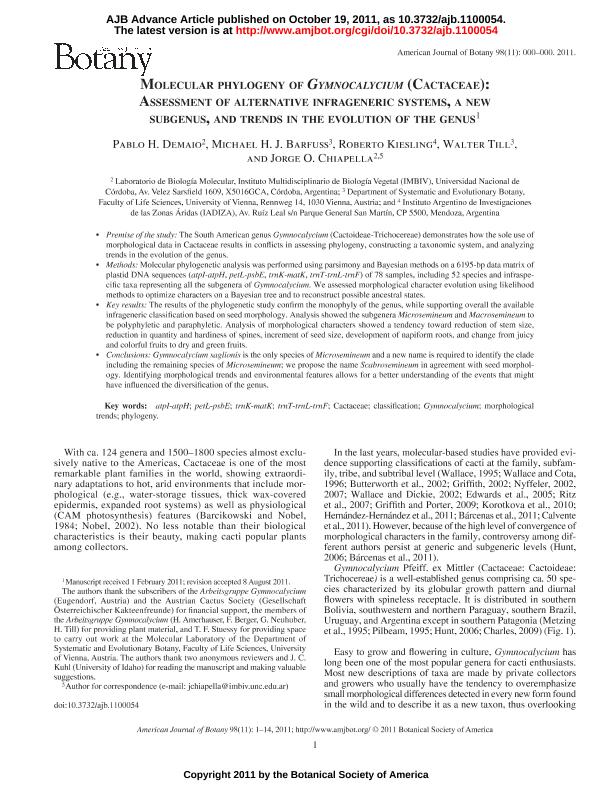Mostrar el registro sencillo del ítem
dc.contributor.author
Demaio, Pablo Horacio

dc.contributor.author
Barfuss, Michael H.J.
dc.contributor.author
Kiesling, Roberto

dc.contributor.author
Till, Walter
dc.contributor.author
Chiapella, Jorge Oscar

dc.date.available
2021-06-17T13:54:19Z
dc.date.issued
2011-11
dc.identifier.citation
Demaio, Pablo Horacio; Barfuss, Michael H.J.; Kiesling, Roberto; Till, Walter; Chiapella, Jorge Oscar; Molecular phylogeny of Gymnocalycium (Cactaceae): Assessment of alternative infrageneric systems, a new subgenus, and trends in the evolution of the genus; Botanical Society of America; American Journal of Botany; 98; 11; 11-2011; 1841-1854
dc.identifier.issn
0002-9122
dc.identifier.uri
http://hdl.handle.net/11336/134066
dc.description.abstract
The South American genus Gymnocalycium (Cactoideae-Trichocereae) demonstrates how the sole use of morphological data in Cactaceae results in conflicts in assessing phylogeny, constructing a taxonomic system, and analyzing trends in the evolution of the genus. Methods: Molecular phylogenetic analysis was performed using parsimony and Bayesian methods on a 6195-bp data matrix of plastid DNA sequences (atpI-atpH, petL-psbE, trnK-matK, trnT-trnL-trnF) of 78 samples, including 52 species and infraspecific taxa representing all the subgenera of Gymnocalycium. We assessed morphological character evolution using likelihood methods to optimize characters on a Bayesian tree and to reconstruct possible ancestral states. Key results: The results of the phylogenetic study confirm the monophyly of the genus, while supporting overall the available infrageneric classification based on seed morphology. Analysis showed the subgenera Microsemineum and Macrosemineum to be polyphyletic and paraphyletic. Analysis of morphological characters showed a tendency toward reduction of stem size, reduction in quantity and hardiness of spines, increment of seed size, development of napiform roots, and change from juicy and colorful fruits to dry and green fruits. Conclusions: Gymnocalycium saglionis is the only species of Microsemineum and a new name is required to identify the clade including the remaining species of Microsemineum; we propose the name Scabrosemineum in agreement with seed morphology. Identifying morphological trends and environmental features allows for a better understanding of the events that might have influenced the diversification of the genus.
dc.format
application/pdf
dc.language.iso
eng
dc.publisher
Botanical Society of America

dc.rights
info:eu-repo/semantics/openAccess
dc.rights.uri
https://creativecommons.org/licenses/by-nc-sa/2.5/ar/
dc.subject
ATPI-ATPH
dc.subject
CACTACEAE
dc.subject
CLASSIFICATION
dc.subject
GYMNOCALYCIUM
dc.subject
MORPHOLOGICAL TRENDS
dc.subject
PETL-PSBE
dc.subject
PHYLOGENY
dc.subject
TRNK-MATK
dc.subject
TRNT-TRNL-TRNF
dc.subject.classification
Ciencias de las Plantas, Botánica

dc.subject.classification
Ciencias Biológicas

dc.subject.classification
CIENCIAS NATURALES Y EXACTAS

dc.subject.classification
Genética y Herencia

dc.subject.classification
Ciencias Biológicas

dc.subject.classification
CIENCIAS NATURALES Y EXACTAS

dc.title
Molecular phylogeny of Gymnocalycium (Cactaceae): Assessment of alternative infrageneric systems, a new subgenus, and trends in the evolution of the genus
dc.type
info:eu-repo/semantics/article
dc.type
info:ar-repo/semantics/artículo
dc.type
info:eu-repo/semantics/publishedVersion
dc.date.updated
2021-06-07T15:26:48Z
dc.identifier.eissn
1537-2197
dc.journal.volume
98
dc.journal.number
11
dc.journal.pagination
1841-1854
dc.journal.pais
Estados Unidos

dc.journal.ciudad
St. Louis
dc.description.fil
Fil: Demaio, Pablo Horacio. Universidad Nacional de Córdoba; Argentina. Consejo Nacional de Investigaciones Científicas y Técnicas. Centro Científico Tecnológico Conicet - Córdoba. Instituto Multidisciplinario de Biología Vegetal. Universidad Nacional de Córdoba. Facultad de Ciencias Exactas Físicas y Naturales. Instituto Multidisciplinario de Biología Vegetal; Argentina
dc.description.fil
Fil: Barfuss, Michael H.J.. Universidad de Viena. Instituto de Botanica; Austria
dc.description.fil
Fil: Kiesling, Roberto. Consejo Nacional de Investigaciones Científicas y Técnicas. Centro Científico Tecnológico Conicet - Mendoza. Instituto Argentino de Investigaciones de las Zonas Áridas. Provincia de Mendoza. Instituto Argentino de Investigaciones de las Zonas Áridas. Universidad Nacional de Cuyo. Instituto Argentino de Investigaciones de las Zonas Áridas; Argentina
dc.description.fil
Fil: Till, Walter. Universidad de Viena. Instituto de Botanica; Austria
dc.description.fil
Fil: Chiapella, Jorge Oscar. Consejo Nacional de Investigaciones Científicas y Técnicas. Centro Científico Tecnológico Conicet - Córdoba. Instituto Multidisciplinario de Biología Vegetal. Universidad Nacional de Córdoba. Facultad de Ciencias Exactas Físicas y Naturales. Instituto Multidisciplinario de Biología Vegetal; Argentina
dc.journal.title
American Journal of Botany

dc.relation.alternativeid
info:eu-repo/semantics/altIdentifier/url/https://bsapubs.onlinelibrary.wiley.com/doi/full/10.3732/ajb.1100054
dc.relation.alternativeid
info:eu-repo/semantics/altIdentifier/doi/http://dx.doi.org/10.3732/ajb.1100054
Archivos asociados
